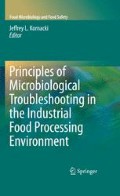Abstract
This chapter focuses on the impact of extrinsic and intrinsic factors that impact the growth of bacteria and fungi in foods. A bacterium with a generation time of 20 min can grow from 1 cell to over a million in 7 h. Intrinsic factors that impact microbial growth or survival are those properties within the food itself. Examples of such factors are the amount of available (not chemically bound) water (i.e., water activity), the oxidation/reduction potential (ORP) of the food, its pH, and the type of acid present. Extrinsic factors are those applied to the food such as thermal processes and refrigeration. Sometimes extrinsic factors such as heating result in creation of intrinsic factors such as a reduced ORP. The dynamic interaction between intrinsic and extrinsic factors will have a profound effect on the type of microbiota in the ingredient, food, and factory environment. The extrinsic and intrinsic factors that impact microbial survival and growth in food or in factory niches are manifold and can be quite dynamic. This highlights the need for research to better understand the relationship of microbes to their environments. Food processors should exercise appropriate caution (e.g., via challenge studies, appropriate testing, selection, and monitoring of valid CCPs) when formulating new products. Assumptions about microbial behavior in one product may not necessarily apply to another.
Our lives are inextricably woven with the lives of these creatures who we ignore until they cause us trouble
– Lynn Margulis and Dorion Sagin, Microcosmos, 1986
Access this chapter
Tax calculation will be finalised at checkout
Purchases are for personal use only
References
Banwart GJ (1979) Basic Food Microbiology. AVI Publishing Company, Westport, CT
Chmielewski R, Frank JF (2004) A predictive model for heat inactivation of Listeria monocytogenes biofilm on stainless steel. J Food Prot 67(12):2712–2718
Frank JF, Marth EH (1977) Inhibition of Enteropathogenic Escherichia coli by homofermentative lactic acid bacteria in skim milk. J Food Prot 40(11):754–759
Jay J (2000) Modern Food Microbiology, 6th edn. Springer, New York
Kornacki JL, Marth EH (1982) Fate of non-pathogenic and enteropathogenic Escherichia coli during the manufacture of Colby-like cheese. J Food Prot 45:310–316
Kornacki JL (1986) Thermal inactivation of bacteria in ultrafiltered milk retentates. Dissertation, University of Wisconsin
Kornacki JL, Gabis DA (1990) Microorganisms and refrigeration temperatures. Dairy, Food Environ Sanit 10(4):192–195
Kornacki JL, Marth EH (1986) Heat-inactivation of Streptococcus faecium var. casseliflavus in skim milk cultures with Pseudomonas fluorescens. J Food Prot 49:541–543
Kornacki JL, Marth EH (1989) Thermal inactivation of Staphylococcus aureus in retentates from ultrafiltered milk. J Food Prot 52:631–637
Kornacki JL, Marth EH (1992) Thermal inactivation of Enterococcus faecium in retentates from ultrafiltered milk. Milchwissenschaft 47(12):764–769
Kornacki JL, Marth EH (1993) Thermal inactivation of Salmonella senftenberg and Micrococcus freudenreichii in retentates from ultrafiltered milks. Lebensm Wiss U-Technol 26:21–27
Lund D (1975) Heat processing, Chapter 3. In: Fennema O (ed) Principles of Food Science Part II: Physical Principles of Food Preservation. Marcel Dekker, New York
Mitscherlich E, Marth EH (1984) Microbial Survival in the Environment. Springer-Verlag, New York, Table 26, p. 584
Ryser ET (1999) Incidence and behavior of Listeria monocytogenes in unfermented dairy products, Chapter 11. In: Ryser ET, Marth EH (eds) Listeria, Listeriosis, and Food Safety, 2nd edn. CRC Press, Boca Raton, FL citing Northholt MD, Beckers HJ, Vecht U, Toepel L, Soentoro PSS, Wisselink HJ (1988) Listeria monocytogenes: Heat resistance and behavior during storage of milk and whey and making of Dutch types of cheese. Neth Milk Dairy J 42:207–219
Tanaka N, Traisman E, Plantong P, Finn L, Flom W, Meskey L, Guggisberg J (1986) Evaluation of factors involved in antibotulinal properties of pasteurized process cheese spreads. J Food Prot 49(7):526–531
Author information
Authors and Affiliations
Corresponding author
Editor information
Editors and Affiliations
Rights and permissions
Copyright information
© 2010 Springer Science+Business Media, LLC
About this chapter
Cite this chapter
Kornacki, J.L. (2010). What Factors Are Required for Microbes to Grow, Survive, and Die?. In: Kornacki, J. (eds) Principles of Microbiological Troubleshooting in the Industrial Food Processing Environment. Food Microbiology and Food Safety. Springer, New York, NY. https://doi.org/10.1007/978-1-4419-5518-0_5
Download citation
DOI: https://doi.org/10.1007/978-1-4419-5518-0_5
Published:
Publisher Name: Springer, New York, NY
Print ISBN: 978-1-4419-5517-3
Online ISBN: 978-1-4419-5518-0
eBook Packages: Chemistry and Materials ScienceChemistry and Material Science (R0)

